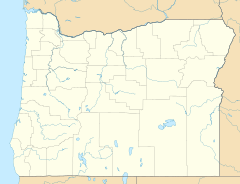Cold Springs, Oregon facts for kids
Quick facts for kids
Cold Springs, Oregon
|
|
|---|---|
| Country | United States |
| State | Oregon |
| County | Umatilla |
| Elevation | 574 ft (175 m) |
| Time zone | UTC-8 (Pacific (PST)) |
| • Summer (DST) | UTC-7 (PDT) |
| Area code(s) | 458 and 541 |
| GNIS feature ID | 1158171 |
Cold Springs is a small, unincorporated community in Umatilla County, Oregon, United States. It is located south of the Columbia River in the Hermiston area. An "unincorporated community" means it's a place where people live, but it doesn't have its own local government like a city or town.
Contents
About Cold Springs
Cold Springs is known for its natural features. These include a wash (a dry streambed), a dam, a reservoir, and a canyon. All these places likely got their name from a local spring that provides cold water.
Cold Springs Junction
About 4 miles (6.4 km) northeast of Cold Springs, you'll find Cold Springs Junction. This is a special spot where two important roads meet. These roads are Oregon Route 37 and U.S. Route 730. It's a key point for travelers in the area.
Railroad History
The area where Cold Springs is today used to be a station for an old railroad company. This company was called the Oregon-Washington Railroad & Navigation Company. Today, this railway line is part of the Union Pacific Railroad. Railroads were very important for moving goods and people in the past.
Cold Springs Post Office
A post office named Cold Springs was opened in 1880. It served the community for a few years before closing in 1883. This post office was located in the Middle Fork Cold Springs Canyon. This spot was west of a place called Myrick. It was also east of the Cold Springs Reservoir. The post office was about 28 miles (45 km) northeast of the Cold Springs railroad station.
Cold Springs Reservoir
The Cold Springs Reservoir was created in the early 1900s. It was formed when the Cold Springs Wash was dammed. A "wash" is a dry streambed that only carries water after heavy rain. The dam was built to store water. This water was taken from the Umatilla River. It was then used for irrigation, which means supplying water to farms to help crops grow. This was very important for farming in the region.


